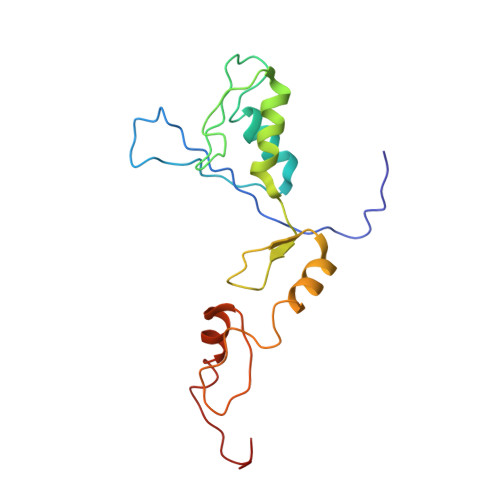Functional and structural basis of the nuclear localization signal in the ZIC3 zinc finger domain
Hatayama, M., Tomizawa, T., Sakai-Kato, K., Bouvagnet, P., Kose, S., Imamoto, N., Yokoyama, S., Utsunomiya-Tate, N., Mikoshiba, K., Kigawa, T., Aruga, J.(2008) Hum Mol Genet 17: 3459-3473
- PubMed: 18716025
- DOI: https://doi.org/10.1093/hmg/ddn239
- Primary Citation of Related Structures:
2RPC - PubMed Abstract:
Disruptions in ZIC3 cause heterotaxy, a congenital anomaly of the left-right axis. ZIC3 encodes a nuclear protein with a zinc finger (ZF) domain that contains five tandem C2H2 ZF motifs. Missense mutations in the first ZF motif (ZF1) result in defective nuclear localization, which may underlie the pathogenesis of heterotaxy. Here we revealed the structural and functional basis of the nuclear localization signal (NLS) of ZIC3 and investigated its relationship to the defect caused by ZF1 mutation. The ZIC3 NLS was located in the ZF2 and ZF3 regions, rather than ZF1. Several basic residues interspersed throughout these regions were responsible for the nuclear localization, but R320, K337 and R350 were particularly important. NMR structure analysis revealed that ZF1-4 had a similar structure to GLI ZF, and the basic side chains of the NLS clustered together in two regions on the protein surface, similar to classical bipartite NLSs. Among the residues for the ZF1 mutations, C253 and H286 were positioned for the metal chelation, whereas W255 was positioned in the hydrophobic core formed by ZF1 and ZF2. Tryptophan 255 was a highly conserved inter-finger connector and formed part of a structural motif (tandem CXW-C-H-H) that is shared with GLI, Glis and some fungal ZF proteins. Furthermore, we found that knockdown of Karyopherin alpha1/alpha6 impaired ZIC3 nuclear localization, and physical interactions between the NLS and the nuclear import adapter proteins were disturbed by mutations in the NLS but not by W255G. These results indicate that ZIC3 is imported into the cell nucleus by the Karyopherin (Importin) system and that the impaired nuclear localization by the ZF1 mutation is not due to a direct influence on the NLS.
- Laboratory for Behavioral and Developmental Disorders, RIKEN Brain Science Institute, Wako-shi, Saitama, Japan.
Organizational Affiliation:

















